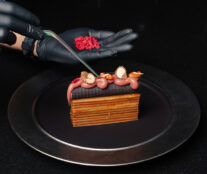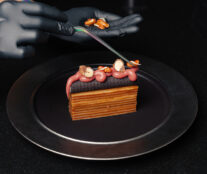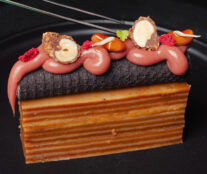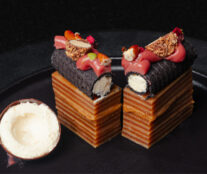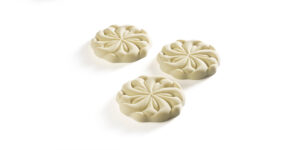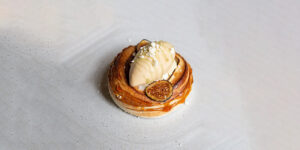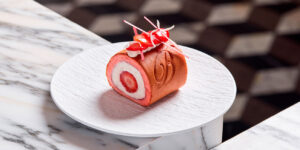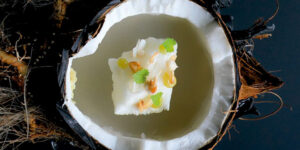Coconut Hazelnut Vanilla Recipes
Bebinca Pudding with Charcoal & Espresso Waffle and Alsande Tonak by Ruchit Harneja
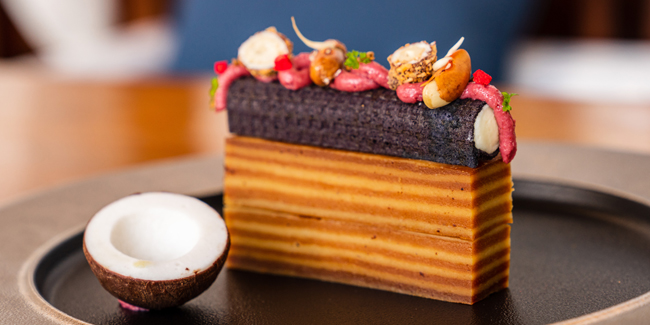
Bebinca is a layered pudding from Goa (India), introduced by the Portuguese during their colonial rule, which combines local ingredients with Portuguese culinary traditions. The name “Bebinca” comes from the Portuguese word “beija-flor”, which means “kiss the flower”, due to its flower petal-like layers. Furthermore, it is one of the favorite desserts at Christmas and Easter, and symbolizes the Catholic celebrations of Goa.
It is made with plain flour, sugar, coconut milk, egg yolks, and spices such as nutmeg and cardamom. It consists of multiple baked layers, creating a dense but moist texture, with a caramelized surface. The dessert is labor-intensive, often prepared at home and passed down from generation to generation.
Ruchit Harneja, the Executive pastry chef of the Musaafer restaurant in Houston, discovered the meticulous preparation and cultural significance of Bebinca through local bakers and home cooks. To elevate the experience, “I incorporated elements inspired by other Goan preparations. A charcoal espresso waffle tube with hazelnut sawdust adds texture, while an Alsande Tonak (spiced kidney bean) cremeux adds complexity and depth. Coconut and vanilla-coated cashews, along with mimicked tender coconut ice cream celebrates Goa’s local treasures,” he explains.
Bebinca Pudding with Charcoal & Espresso Waffle and Alsande Tonak
Six portions
Bebinca
- 200 g refined flour
- 10 egg yolks
- 500 g sugar
- 750 ml coconut milk
- 5 g nutmeg powder
- 250 g butter
- 75 ml Dark black caramel
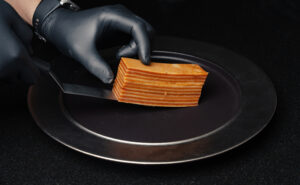 In a mixing bowl, whip the egg yolks and sugar together until they reach a pale white foam consistency. Add the coconut milk to the mixture and mix thoroughly. Gradually fold in all the dry ingredients into the yolk and coconut mixture, ensuring they are well incorporated. Melt the butter and bring it to room temperature. Gently fold the melted butter into the yolk and coconut mixture, making sure it is evenly distributed. Divide the mixture into two parts and add dark caramel to one part to create a darker color. Preheat the oven to 200°C (392°F). Line a baking pan with aluminum foil and pour the batter into the pan. Bake for approximately 12 minutes at 200°C (392°F) until the top is golden brown. Repeat the process, alternating layers of the light and dark mixtures, for a total of seven layers to achieve the distinct white and brown layers. Allow the baked pudding to cool down to room temperature. Transfer to the freezer and let it freeze for at least 12 hours to firm up. Remove from the freezer and cut the cake into rectangular slices, approximately 11cm long and 2.5cm wide. Once you have achieved the desired number of layers, remove the tray from the oven and allow the Bebinca to cool on a wire rack. This step is essential as it allows the dessert to set and firm up, ensuring that each slice maintains its distinct layers.
In a mixing bowl, whip the egg yolks and sugar together until they reach a pale white foam consistency. Add the coconut milk to the mixture and mix thoroughly. Gradually fold in all the dry ingredients into the yolk and coconut mixture, ensuring they are well incorporated. Melt the butter and bring it to room temperature. Gently fold the melted butter into the yolk and coconut mixture, making sure it is evenly distributed. Divide the mixture into two parts and add dark caramel to one part to create a darker color. Preheat the oven to 200°C (392°F). Line a baking pan with aluminum foil and pour the batter into the pan. Bake for approximately 12 minutes at 200°C (392°F) until the top is golden brown. Repeat the process, alternating layers of the light and dark mixtures, for a total of seven layers to achieve the distinct white and brown layers. Allow the baked pudding to cool down to room temperature. Transfer to the freezer and let it freeze for at least 12 hours to firm up. Remove from the freezer and cut the cake into rectangular slices, approximately 11cm long and 2.5cm wide. Once you have achieved the desired number of layers, remove the tray from the oven and allow the Bebinca to cool on a wire rack. This step is essential as it allows the dessert to set and firm up, ensuring that each slice maintains its distinct layers.
Charcoal & Espresso Waffle Tube
- 200 g egg
- 368 g sugar
- 60 ml milk
- 2 espresso shots
- 106 g melted butter
- 112 g refined flour
- 4 g salt
- 4 g activated charcoal powder
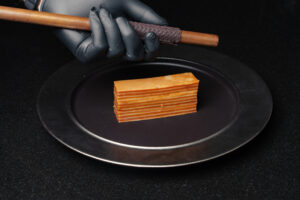 In a mixing bowl, whisk together the eggs and sugar until well combined and the sugar is dissolved. Add the milk, espresso shots, and melted butter to the egg and sugar mixture. Mix until all the ingredients are incorporated. Sift the refined flour, salt, and activated charcoal powder into the wet mixture. Stir until you have a smooth batter with no lumps. Preheat a waffle iron according to the manufacturer’s instructions. Grease the waffle iron with a small amount of oil or melted butter to prevent sticking. Pour a portion of the batter onto the preheated waffle iron and cook until the waffle is cooked and crispy. Remove the cooked waffle from the iron and, while still warm, cut them into rectangles measuring 11 cm x 2.5 cm. Take a 1 cm diameter tube or cylinder-shaped object and roll the warm waffle rectangle around it to form a tube shape. Hold it in place for a few seconds to allow it to set. Let the waffle tubes cool completely on a wire rack to maintain their shape. Using a piping bag filled with melted dark chocolate, carefully pipe the chocolate into the hollow center of each waffle tube, ensuring to fill it completely. Hold each waffle tube upright and gently rotate it to allow the chocolate to coat the interior evenly, forming a layer of chocolate lining. Once the chocolate has coated the inside of the waffle tube, pour out any excess chocolate, allowing it to drain out completely. Place the chocolate-filled waffle tubes on a wire rack or parchment-lined tray. Allow the chocolate filling to set and firm up. This can be done at room temperature or by placing the filled waffle tubes in the refrigerator for a short time. Once the chocolate filling is set and has formed a solid coating inside the waffle tubes, they are ready to be used.
In a mixing bowl, whisk together the eggs and sugar until well combined and the sugar is dissolved. Add the milk, espresso shots, and melted butter to the egg and sugar mixture. Mix until all the ingredients are incorporated. Sift the refined flour, salt, and activated charcoal powder into the wet mixture. Stir until you have a smooth batter with no lumps. Preheat a waffle iron according to the manufacturer’s instructions. Grease the waffle iron with a small amount of oil or melted butter to prevent sticking. Pour a portion of the batter onto the preheated waffle iron and cook until the waffle is cooked and crispy. Remove the cooked waffle from the iron and, while still warm, cut them into rectangles measuring 11 cm x 2.5 cm. Take a 1 cm diameter tube or cylinder-shaped object and roll the warm waffle rectangle around it to form a tube shape. Hold it in place for a few seconds to allow it to set. Let the waffle tubes cool completely on a wire rack to maintain their shape. Using a piping bag filled with melted dark chocolate, carefully pipe the chocolate into the hollow center of each waffle tube, ensuring to fill it completely. Hold each waffle tube upright and gently rotate it to allow the chocolate to coat the interior evenly, forming a layer of chocolate lining. Once the chocolate has coated the inside of the waffle tube, pour out any excess chocolate, allowing it to drain out completely. Place the chocolate-filled waffle tubes on a wire rack or parchment-lined tray. Allow the chocolate filling to set and firm up. This can be done at room temperature or by placing the filled waffle tubes in the refrigerator for a short time. Once the chocolate filling is set and has formed a solid coating inside the waffle tubes, they are ready to be used.
Hazelnut Serradura
- 100 g heavy whipping cream
- 60 g condensed milk
- 20 g toasted hazelnuts
- 20 g milk chocolate
- 20 g feuilletine
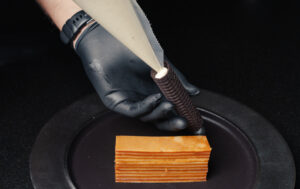 In a large mixing bowl, combine the heavy whipping cream and condensed milk. Whip the cream and condensed milk together until you achieve a whipped peak consistency. In a separate bowl, crush the toasted hazelnuts along with the feuilletine until you have a coarse mixture. Melt milk chocolate and temper. Pour the tempered milk chocolate into the crushed hazelnut and feuilletine mixture. Mix well until all the ingredients are evenly coated with chocolate. Spread the mixture onto a silicone mat or parchment paper and allow it to set at room temperature until firm. Once the mixture has set, break it into smaller pieces and transfer it to a blender or food processor. Pulse the mixture until you achieve a fine powder consistency. This will be the hazelnut and feuilletine powder. Prepare the charcoal waffle tube by filling it with the whipped cream and condensed milk mixture. Use a piping bag or spoon to alternate layers of the whipped mixture and the crushed hazelnut and feuilletine powder. Continue layering until the tube is filled, ending with a layer of the whipped mixture on top.
In a large mixing bowl, combine the heavy whipping cream and condensed milk. Whip the cream and condensed milk together until you achieve a whipped peak consistency. In a separate bowl, crush the toasted hazelnuts along with the feuilletine until you have a coarse mixture. Melt milk chocolate and temper. Pour the tempered milk chocolate into the crushed hazelnut and feuilletine mixture. Mix well until all the ingredients are evenly coated with chocolate. Spread the mixture onto a silicone mat or parchment paper and allow it to set at room temperature until firm. Once the mixture has set, break it into smaller pieces and transfer it to a blender or food processor. Pulse the mixture until you achieve a fine powder consistency. This will be the hazelnut and feuilletine powder. Prepare the charcoal waffle tube by filling it with the whipped cream and condensed milk mixture. Use a piping bag or spoon to alternate layers of the whipped mixture and the crushed hazelnut and feuilletine powder. Continue layering until the tube is filled, ending with a layer of the whipped mixture on top.
Alsande Cremeux
- 4 g cloves
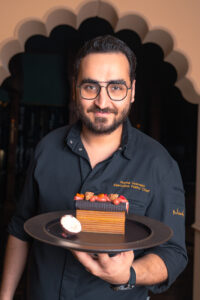
- 2 g coriander seeds
- 7 g peppercorns
- 7 g poppy seeds
- 1 u medium onion, chopped
- 1 u medium potato, chopped
- 100 g fresh coconut, grated
- 8 g sugar
- 3 g red chilli powder
- 150 g Kidney beans, soaked
- 200 ml water
- 100 ml cream
- 60 ml milk
- 135 g castor sugar
- 135 g whole egg
- 7 g gelatin, bloomed in 60 ml water
- 135 g butter
- 30 ml lemon juice
- red food coloring
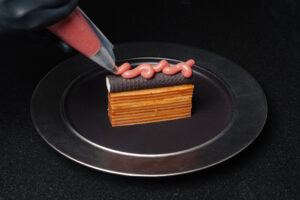 In a pan, dry roast cloves, coriander seeds, peppercorns, and poppy seeds. Grind the roasted spices into a fine powder. In a separate pan, heat some oil and sauté the chopped onion and potato until golden brown. Add grated coconut, sugar, red chilli powder, and the ground spice powder to the pan. Mix well. Add soaked kidney beans and water. Cook until the beans are tender and then allow to chill over an ice bath. In a separate bowl, combine cream, milk, and castor sugar and cook till 82C. Add whole eggs and stir continuously. Add bloomed gelatin to the mixture and stir well. Allow the mixture to cool to 105°F (35°C), then add butter and blend it with a hand blender until smooth. Sieve the mashed alsande (kidney beans) and add 300 grams it to the butter cremeux. Finish with lemon juice and blend until smooth. Use a touch of red food coloring.
In a pan, dry roast cloves, coriander seeds, peppercorns, and poppy seeds. Grind the roasted spices into a fine powder. In a separate pan, heat some oil and sauté the chopped onion and potato until golden brown. Add grated coconut, sugar, red chilli powder, and the ground spice powder to the pan. Mix well. Add soaked kidney beans and water. Cook until the beans are tender and then allow to chill over an ice bath. In a separate bowl, combine cream, milk, and castor sugar and cook till 82C. Add whole eggs and stir continuously. Add bloomed gelatin to the mixture and stir well. Allow the mixture to cool to 105°F (35°C), then add butter and blend it with a hand blender until smooth. Sieve the mashed alsande (kidney beans) and add 300 grams it to the butter cremeux. Finish with lemon juice and blend until smooth. Use a touch of red food coloring.
Vanilla & coconut coated cashews
- 250 g raw cashews
- 50 g granulated sugar
- 60 ml water
- 5 g vanilla extract
- 100 g shredded coconut (sweetened or unsweetened)
- pinch of salt
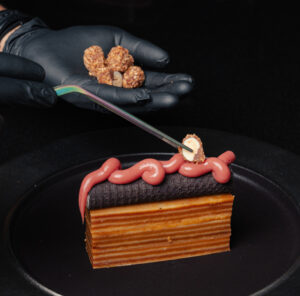 Preheat your oven to 350°F (175°C) and line a baking sheet with parchment paper or a silicone mat. In a small saucepan, combine the granulated sugar and water. Heat over medium heat, stirring occasionally, until the sugar has dissolved completely. Remove the saucepan from heat and stir in the vanilla extract. In a separate bowl, combine the cashews and the sugar syrup, stirring well to ensure all the cashews are coated. Spread the cashews evenly on the prepared baking sheet and sprinkle them with a pinch of salt. Place the baking sheet in the preheated oven and bake for about 12-15 minutes, or until the cashews are golden brown and toasted. Stir them once or twice during baking to ensure even browning. While the cashews are baking, spread the shredded coconut on another baking sheet and toast it in the oven for about 5 minutes, or until it turns lightly golden. Keep a close eye on the coconut as it can quickly burn. Remove both the cashews and toasted coconut from the oven and allow them to cool for a few minutes. Once the cashews have cooled, melt the dark chocolate in a heatproof bowl over simmering water or in short intervals in the microwave, stirring until smooth. Enrobe cashews into the tempered dark chocolate, coating it entirely & sprinkle the shredded coconut over it, pressing gently to adhere the coconut flakes. Allow the chocolate and coconut coating to set at room temperature or refrigerate for a short time until firm. Once set, gently remove the coated cashews from the baking sheet and store them in an airtight container.
Preheat your oven to 350°F (175°C) and line a baking sheet with parchment paper or a silicone mat. In a small saucepan, combine the granulated sugar and water. Heat over medium heat, stirring occasionally, until the sugar has dissolved completely. Remove the saucepan from heat and stir in the vanilla extract. In a separate bowl, combine the cashews and the sugar syrup, stirring well to ensure all the cashews are coated. Spread the cashews evenly on the prepared baking sheet and sprinkle them with a pinch of salt. Place the baking sheet in the preheated oven and bake for about 12-15 minutes, or until the cashews are golden brown and toasted. Stir them once or twice during baking to ensure even browning. While the cashews are baking, spread the shredded coconut on another baking sheet and toast it in the oven for about 5 minutes, or until it turns lightly golden. Keep a close eye on the coconut as it can quickly burn. Remove both the cashews and toasted coconut from the oven and allow them to cool for a few minutes. Once the cashews have cooled, melt the dark chocolate in a heatproof bowl over simmering water or in short intervals in the microwave, stirring until smooth. Enrobe cashews into the tempered dark chocolate, coating it entirely & sprinkle the shredded coconut over it, pressing gently to adhere the coconut flakes. Allow the chocolate and coconut coating to set at room temperature or refrigerate for a short time until firm. Once set, gently remove the coated cashews from the baking sheet and store them in an airtight container.
Tender coconut ice cream
- 200 g tender coconut flesh (fresh or canned)
- 100 g coconut puree
- 200 g heavy cream
- 150 g whole milk
- 100 g granulated sugar
- 3 g ice cream stabilizer
- 100 g dark chocolate (for coating)
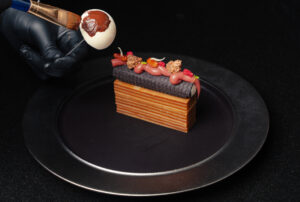 In a blender or food processor, combine the tender coconut flesh, coconut puree, heavy cream, whole milk, granulated sugar, and ice cream stabilizer. Blend until you achieve a smooth and well-incorporated mixture. Pour the ice cream base into a saucepan and heat over medium heat, stirring constantly until the mixture reaches 85°C (185°F). This step helps to activate the stabilizer and pasteurize the mixture for better texture and safety. Remove the mixture from the heat and let it cool to room temperature. Once the mixture has cooled, cover it with plastic wrap, ensuring the plastic wrap touches the surface of the mixture to prevent a skin from forming. Refrigerate for at least 4 hours or overnight to allow the flavors to develop. After the mixture has chilled, pour it into the bowl of an ice cream churner. Churn according to the manufacturer’s instructions until the mixture reaches a soft-serve consistency. Transfer the churned ice cream into semisphere silicone molds, filling them to the top. Smooth the surface with a spatula. Place the filled molds in the freezer and let them set for at least 6 hours or until completely firm. Once the ice cream has hardened, remove the molds from the freezer. Use a melon baller or a small spoon to carefully scoop out a portion from the center of each semisphere, creating a hollow cavity. Return the hollowed semispheres to the freezer and let them freeze for an additional 1-2 hours to firm up again. Melt the dark chocolate in a microwave-safe bowl or over a double boiler until smooth and melted. Remove the frozen semispheres from the freezer. Dip each semisphere into the melted chocolate, allowing any excess to drip off. Place the coated semispheres on a parchment-lined tray or baking sheet. Using a hard brush, lightly brush the surface of the chocolate-coated semispheres to create a brushed effect, resembling a coconut’s texture. Return the coated semispheres to the freezer and let them freeze for an additional 1-2 hours or until the chocolate coating is firm.
In a blender or food processor, combine the tender coconut flesh, coconut puree, heavy cream, whole milk, granulated sugar, and ice cream stabilizer. Blend until you achieve a smooth and well-incorporated mixture. Pour the ice cream base into a saucepan and heat over medium heat, stirring constantly until the mixture reaches 85°C (185°F). This step helps to activate the stabilizer and pasteurize the mixture for better texture and safety. Remove the mixture from the heat and let it cool to room temperature. Once the mixture has cooled, cover it with plastic wrap, ensuring the plastic wrap touches the surface of the mixture to prevent a skin from forming. Refrigerate for at least 4 hours or overnight to allow the flavors to develop. After the mixture has chilled, pour it into the bowl of an ice cream churner. Churn according to the manufacturer’s instructions until the mixture reaches a soft-serve consistency. Transfer the churned ice cream into semisphere silicone molds, filling them to the top. Smooth the surface with a spatula. Place the filled molds in the freezer and let them set for at least 6 hours or until completely firm. Once the ice cream has hardened, remove the molds from the freezer. Use a melon baller or a small spoon to carefully scoop out a portion from the center of each semisphere, creating a hollow cavity. Return the hollowed semispheres to the freezer and let them freeze for an additional 1-2 hours to firm up again. Melt the dark chocolate in a microwave-safe bowl or over a double boiler until smooth and melted. Remove the frozen semispheres from the freezer. Dip each semisphere into the melted chocolate, allowing any excess to drip off. Place the coated semispheres on a parchment-lined tray or baking sheet. Using a hard brush, lightly brush the surface of the chocolate-coated semispheres to create a brushed effect, resembling a coconut’s texture. Return the coated semispheres to the freezer and let them freeze for an additional 1-2 hours or until the chocolate coating is firm.
Montage
- freeze dried raspberries
- micro cilantro
- sprouted kidney bean
Gently place a warm slice of Bebinca on a plate, ensuring it is positioned neatly. Carefully position the charcoal waffle tube filled with hazelnut serradura on top of the Bebinca slice. Using a round piping tip, pipe the Alsande cremeux onto the waffle tube, adding a touch of sophistication to the presentation. Halve the vanilla and coconut coated cashews and artfully assemble them on top of the Alsande cremeux. Arrange sprouted kidney beans, micro cilantro, and freeze-dried raspberry crisps as well on top of the alsande cremeux. Complete the presentation by placing a portion of mimicked tender coconut ice cream alongside the ensemble.
